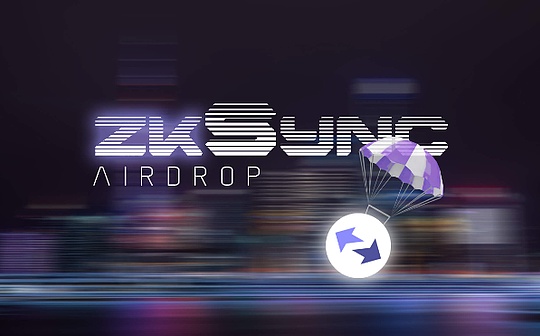
Author: @Web3Mario
Abstract: The hottest topic last week must have been the public airdrop inspection incident of ZKsync. I was originally learning and writing some learning experiences about TON’s DApp development, but seeing this controversial incident and the widespread communityI have some feelings about the discussion, so I wrote an article and hope to share it with you.In general, ZKSync’s airdrop solution adopts a property proof-based distribution method, focusing more on rewards to developers, core contributors and ZKSync native Degen giant whale, which creates a situation where Native Degen giant whale is laughing., the hair-pulling studio is shouting.
The focus of community debate: Is interaction key or amount of capital key
For a long time, the Web3 industry seems to have formed a paradigm for attracting users to use products through Airdrop, thus achieving cold start to projects.This is especially true in the Layer2 track. By guiding developers and users’ expectations of potential airdrops, developers are stimulated to actively build and maintain DApps, while stimulating users to bridge funds to target Layer2 in the early stages of development and actively participate in the running of target Layer2 on the target Layer2.DApp, thus playing the purpose of active ecology, has become a standard.
Therefore, in the past, users’ general airdrop expectations for ZKSync were compared with its two direct competitors, Arbitrum and Optimism.Of course, this conclusion is logical whether it is considered from the perspective of industry influence, VC background, fundraising scale, etc., but the results are very different, which has led to many users who reuse past experience to participate in ZKSync.the number of rewards within, which led to the community falling into widespread debate.
In order to explore the reasons behind this debate and explore some reference significance for the future, it is naturally necessary to review the previous settings of Arbitrum and Optimism’s airdrop rules.First, we will review Arbitrum’s airdrop activity, which dates back to March 2023, when it allocated Arb airdrops to Aribitrum users that accounted for 11.62% of the total supply, and 1.13% of Arb airdrops to DAOs operating in the Arbitrum ecosystem.The settings of the airdrop activity are based on snapshot data from February 6, 2023. The specific rules for users are as follows:
-
Cross-chain to Arbitrum: Users need to transfer funds to Arbitrum One or Arbitrum Nova.
-
Transactions in different time periods: Users have traded in two different months, six different months, or nine different months.
-
Transaction frequency and interaction: Users have made more than 4, 10, 25 or 100 transactions, or interacted with the corresponding number of smart contracts.
-
Transaction Value: The total value of transactions conducted by the user exceeds USD 10,000, USD 50,000 or USD 250,000.
-
Liquidity provided: Users have deposited more than $10,000, $50,000 or $250,000 in liquidity
-
Arbitrum Nova activity: Users have made more than 3, 5 or 10 transactions on Arbitrum Nova.
Each rule will have a specific calculation method for the score, with the upper limit of the score being 15 points. This score is used to determine the number of Arbs that users can claim. The calculation method can be approximate to a linear relationship, but the starting reward starts from 3 points and the top isRewards of 10,200 Arbs.The rewards for DAOs are directly determined according to the activity assessment. From the results, the final 137 DAOs received airdrops, of which Treasure and GMX obtained the most, with 8 million Arbs respectively, according to the current essence., this is really a huge profit.
Next, let’s review Optimism. Unlike Arbitrum, Optimism’s airdrops were conducted in multiple rounds, with a total of 19% of the total supply. The earliest first round of airdrop activities dates back to June 2022, with a total of5% of the rewards were distributed to 260,000 addresses. As of now, four rounds of airdrops have been carried out. The specific rules for each round of airdrop are as follows:
-
Round 1: The ordinary user and active user are divided according to the number of transactions, corresponding to the address of 1 transaction and the address of more than 4 transactions, as well as participants of Ethereum DAO, Ethereum multi-sign wallet users, Gitcoin donors and cross-chainBridge user.Each identity corresponds to a fixed-value reward, and the last three rewards can be stacked.
-
The second round: The total transaction gas fee is greater than US$6.1 or users with a currency age of more than 2,000 participating in the entrusted governance can divide up 11,742,277 $OPs;
-
The third round: Users with a coin age of more than 18,000 participating in the entrusted governance can divide up 19,411,313 $OPs;
-
Round 4: 10,343,757 $OPs were allocated to the creators of NFTs;
From the above review, it is not difficult to find that the number of interactions will be used as an important reference indicator in its specific activity settings. The more frequent interactions the more rewards the users can usually receive.However, this unspoken rule seems to be abandoned by ZKSync. In the airdrop design of ZKSync, the qualifications and allocation of ZKsync users are divided into four consecutive steps to select and calculate. The specific rules are roughly as follows:
-
Qualification Filter: Each address that has been traded on ZKsync Era and ZKsync Lite is checked based on the qualification criteria.It has set up 7 inspection criteria to screen eligible users, such as interacting with non-token contracts for more than 10 and non-token contracts must have at least 30 days of active time, sending at least 5 transactions in ZKsync Era, etc.
-
Allocation: When calculating the specific number of rewards for an address that meets the above criteria, it is confirmed based on a value scaling formula that calculates a time-weighted average based on the amount sent to ZKsync Era and the time these crypto assets are retained in the wallet.and use this to adjust the allocation of each address. At the same time, funds participating in the DApp protocol will receive a 2x bonus, which means you have transferred large funds to ZKSync, maintained for a long time, and actively used theseFunds will receive more rewards by participating in risky products, such as providing liquidity to DEX.
-
Multiplier: Addresses that meet certain criteria can obtain multiplier in the allocation.These standards are usually holding some high-risk ZKSync native altcoins or NFTs.
-
Sybil detection: Finally, ZKSync will also perform witch attack detection to ensure that most robots are filtered out. The detection standards are carried out from two aspects: the first ETH source after the creation of an EOA address, as well as the EOA address and the CEX deposit address.interaction situation.In fact, this also takes advantage of the characteristics of CEX KYC.
From the specific rules, it is not difficult to find that the calculation of rewards does not involve the number of interactions, but focuses more on the amount of funds in a single account and the willingness to allocate risk assets.Therefore, when the results were announced, many hair-fucking parties or studios who had a lot of interactions on ZKSync were surprised, which was also the source of the entire controversy.Because in order to increase the number of addresses to obtain potential airdrops, this part of users usually choose to distribute large funds into address groups as much as possible. These address groups are usually hundreds or even thousands, and use small funds to participate in a certain agreement.Determine some possible incentive behaviors, frequently brush interactions through automated scripts or manual methods, and improve potential benefits by doing tasks.The airdrop settings of ZKSync have invalidated this strategy. Many frequently interacting addresses pay higher fees than rewards, which naturally aroused dissatisfaction among this group of people.
Moreover, it is not difficult for us to find a large number of airdrop hunter KOLs in X. This group of people publish content on the theme of teaching everyone how to easily obtain project airdrops. They usually have a wide fan base and are highly appealing, so they are given through social media.ZKSync official pressure is expected to change the situation.However, from the official attitude, it seems to be very tough and the rules have not been modified due to pressure, so the current situation is here.The criticisms and excuses for some possible evil behaviors triggered during the debate are the highlights of this public opinion war.
Judging from the results, the demands on both sides seem to be understandable. The right and wrong can only be discussed from the perspective, but I think some things are worth thinking about, that is, today, the core of the cold start stage of the Web3 projectWho is the value user, or what kind of user is the user that should be motivated in the cold start stage.
Re-interaction brings witch attack problems, property proof brings monopoly problems
Based on Airdrop rewards for early bird participants, it has proven to be an effective cold start method for Web3 projects. Good airdrop mechanism settings can help projects to attract seed users efficiently in the early stages, while stimulating users to the key behaviors of the protocol.Use it to complete user education and increase product stickiness.This is also the fundamental reason why most Web3 projects have been airdrop settings for a long time to focus on incentivizing interactive behavior. However, this has brought one disadvantage, which is that it lowers the threshold for rewards and easily causes the activity to be attacked by witches.Because interactive behavior is easy to be automated and batched, this gives many professional teams room for batch operations. When a large number of robot accounts pour in, although the protocol will be temporarily boomed, these “users” are usually gradualLiving in aquatic plants cannot provide impetus for the future development of the project. After receiving the reward, most of them will be cashed out to increase the turnover rate of funds and increase returns. This incentive mechanism actually dilutes the number of rewards that the project party has for those real value users.It’s really not worth the loss.
So why did this mechanism work well in the early stage? This is naturally because there were not so many similar professional teams at that time, and most users have not yet formed a thinking habit of this incentive mechanism. The interaction behavior is relatively pure and real.Users, this allows incentives to be distributed more efficiently to these users. The resulting wealth effect also helps the project party realize the above benefits. However, with the impact of the money-making effect, this method is obviously no longer effective.Attract real users.My personal experience is that the effect of the airdrop activity with interaction as the main motivation object has basically reached its peak when Arbitrum airdrops are released.
This is also the fundamental reason why ZKSync wants to abandon the use of interaction numbers as the basis for value users to identify around the relative scale of assets.However, this kind of property proof method may not be without problems.Although it can more effectively identify and eliminate the risk of witch attacks, the new problem that comes with it is the uneven distribution of wealth caused by monopoly.
We know that one of the core values of Web3 projects is the bottom-up distributed autonomy model.This means that the support of grassroots users (real users with small amounts of funds) is the basic foundation for project development.It is precisely because of grassroots users that some giant whale users can pour in and form a relatively sustainable development form. After all, the financial advantages are still available in most scenarios. Only grassroots users have enough money, and the benefits of giant whale users areOnly big enough.Then the distribution system of property certificates will lead to the fact that at the beginning of the cold start, the benefits of giant whale users among its early bird users are already more obvious, which makes it difficult to form an effective incentive for grassroots users, and naturally it is impossible to form a cohesive community.
In the final analysis, for Web3 projects, when designing a cold start mechanism, you should carefully consider the value user portrait for your products, and design the corresponding mechanism based on the current environment to effectively motivate the above value users while trying to do the same.Avoiding witch attacks is the top priority.Therefore, how to design your own cold start mechanism is a very valuable topic, and everyone is also welcome to leave a message in my X for discussion.Brainstorm some interesting solutions together.








